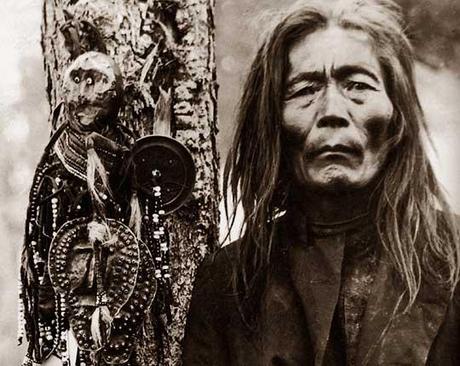If we assume that what western clinicians call “schizophrenia” is a neurobiological condition, we would expect to find it among all humans. We should, in other words, be able to identify it in historical records regardless of time or place. Given this expectation, it’s not surprising that a number of scholars have argued that shamans display the classic signs of schizophrenia or other mental illnesses. Appropriately enough, I’ve been of two minds on the issue.
On the one hand, my reading of ethnographic and ethnohistoric records has never caused me to think that shamans are mentally ill or otherwise disordered. In most cases, shamans must — when not engaged in shamanic activities — be functioning and contributing members of their societies. They are not full-time specialists devoted solely to shamanizing. It’s hard to imagine them doing this while laboring under the kind of full-blown delusion and debilitation which characterizes the most severe forms of schizophrenia. There are numerous accounts in the literature of shamans being killed for some imagined offense (i.e., casting harmful spells or causing spirits to attack) which makes me think that their sometimes shorter life expectancies may not just be an occupational hazard. It could be that killing shaman-schizophrenics was an occasionally accepted way of dealing with those who had become too socially disruptive.
On the other hand, some of the literature suggesting that shamans may be schizophrenics has been the result of direct fieldwork and close observation. While the observers may not have been trained clinicians, it is hard to discount their informed assessments. This may just be a classic case of variation — in every society past and present, a certain number of people will suffer from schizophrenia or similar disorders and all societies have had to confront the issue. In non-institutional societies, this may have been dealt with by directing at least some of these people toward shamanic roles. This would mean that some, but not all, shamans may have been schizophrenic.
I was reminded of all this because over at Aeon, Mike Joy has written an article showing that the ways in which schizophrenia manifests — in terms of reported symptoms or delusions — has changed over historical time. Schizophrenia, in other words, is at least in part culturally constructed:
Persecutory delusions, for example, can be found throughout history and across cultures; but within this category a desert nomad is more likely to believe that he is being buried alive in sand by a djinn, and an urban American that he has been implanted with a microchip and is being monitored by the CIA.
All people, including the mentally disordered, work with what they know and available cultural materials. So this makes sense. I am less sure about western attempts to explain the underlying etiology, which Joy here describes:
At the core of schizophrenia, Victor Tausk argued, was a ‘loss of ego-boundaries’ that made it impossible for subjects to impose their will on reality, or to form a coherent idea of the self. Without a will of their own, it seemed to them that the thoughts and words of others were being forced into their heads and issued from their mouths, and their bodies were manipulated like puppets, subjected to tortures or arranged in mysterious postures. These experiences made no rational sense, but those who suffered them were nevertheless subject to what Tausk called ‘the need for causality that is inherent in man’. They felt themselves at the mercy of malign external forces, and their unconscious minds fashioned an explanation from the material to hand, often with striking ingenuity. Unable to impose meaning on the world, they became empty vessels for the cultural artefacts and assumptions that swirled around them.
Tausk’s theory was radical in its implication that the utterances of psychosis were not random gibberish but a bricolage, often artfully constructed, of collective beliefs and preoccupations. Throughout history up to this point, the explanatory frame for such experiences had been essentially religious: they were seen as possession by evil spirits, divine visitations, witchcraft, or snares of the devil. In the modern age, these beliefs remained common, but alternative explanations were now available.
While parts of this accurately reflect descriptions of shamans found in the ethnographic literature, other parts do not. Shamans, for instance, may indeed have a loss of “ego boundaries” but it would be hard to say they cannot impose their will on reality or form a sense of self. Indeed, a primary feature of shamans is that they have excess “will” and “self” — they create and explain in ways that seem uniquely real not only to them but also to those around them. Far from being “unable to impose meaning on the world,” they are expert at it.
Moreover, while shamans may occasionally be manipulated and “at the mercy” of possession spirits, this is usually considered dangerous and undesirable. Shamans were (and are) famous for fighting such takeovers or possessions. While I suppose these fights could be construed in modern-medical terms as an effort to stave off the dissolution of self caused by persistent or involuntary delusions, this seems doubtful because a hallmark of shamanizing is the ability to control spirits and put them to work. In the literature I’ve read, shamans function quite normally (i.e., without delusion) most of the time and only occasionally engage in activities that could be considered schizophrenic or delusional.
In the end, I doubt that most shamans were schizophrenic or suffering from other mental disorders. Even if they were, these unusual experiences and fantastic reports were so thoroughly integrated into society, and accepted by others, that it calls into question our own culturally constructed category of “illness.”



posted on 21 May at 01:06
You might then be interested in my work in this regard and my book called The Bridge Between Two Worlds. A Shamans view of Schizophrenia & Acute Sensitivity. www. contemporaryshaman.net